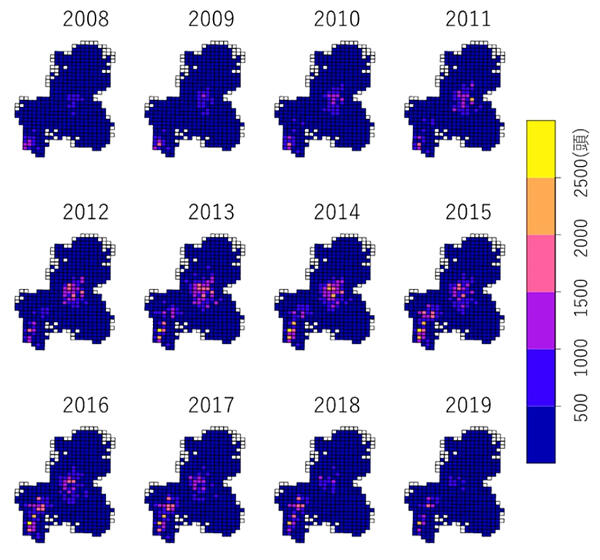Increases in the abundance of sika deer have caused agricultural and forestry damage and decreased vegetation in deer habitats; population control is one means of overcoming this problem. To manage the abundance of large herbivores, it is necessary to determine their population. Harvest‐based models (HBMs) have been used to estimate the abundance of animals in various areas of Japan. However, differences in estimates based on the structure of HBMs and the possibility of incorrect estimation resulting from the use of inappropriate model structures have not been widely evaluated. Additionally, most abundance estimations conducted for sika deer protection and management in Japan were based on large areas, such as by considering a prefecture as one unit. Although limited, estimations performed at high spatial resolution can reveal regional differences in habitat density.
Associate Professor Masaki Ando of the Faculty of Applied Biological Sciences, Gifu University, Specially Appointed Associate Professor Takashi Ikeda of the Research Center for Wildlife Management, Gifu University, and Senior Researcher Hayato Iijima of the Department of Wildlife Biology, Forestry and Forest Products Research Institute, along with their colleagues, utilized monitoring data collected over several years in Gifu Prefecture, such as the number of captured deer and pellet group density, to construct appropriate HBMs. The researchers estimated the sika deer abundance at high spatial resolution using 5‐km square grid cells (hunting mesh unit).

Source of the based HBM: Iijima, H., Nagaike, T., & Honda, T. (2013). Estimation of deer population dynamics using a bayesian state ‐ space model with multiple abundance indices. The Journal of Wildlife Management, 77(5), 1038‐1047.
Provided by Gifu University
The group showed that differences in the population trends of sika deer can be estimated based on regional differences, such as the abundance and hunting pressure, within a single HBM. Their results were published in Mammal Study, an international journal of The Mammal Society of Japan. Several HBMs were constructed based on HBM structures with high spatial resolution in a hunting mesh unit to maximize the utilization of sika deer monitoring data collected in Gifu Prefecture from 2008 to 2019 to estimate the abundance and verify the validity of the estimates.
In contrast to questionnaire survey data on the number of sika deer observed by hunters, which vary greatly among individuals depending on the hunting style and time spent hunting, filed survey data such as the number of pellet groups collected by experts according to predetermined procedures may show less variation and have greater objectivity as an indicator of the sika deer abundance.
Focusing on the quality differences in monitoring data collected using various methods, the group constructed several models and estimated sika deer abundance; however, they could not adequately estimate the abundance in the model in which data obtained from hunter questionnaires were treated similarly to filed survey data obtained using predetermined procedures. In contrast, the model that relied more strongly on field survey data than on questionnaire surveys produced realistic abundance estimates. Additionally, they estimated the biased distribution of sika deer abundance and regional differences with increasing and decreasing tendencies within a single model at high resolution.
Specifically, sika deer are abundant in two regions, namely, the central and southwestern parts of the prefecture. In the central part, deer abundance increased until 2014 and then decreased until 2019; the decreasing trend was less pronounced in the southwestern region than in the central region. This trend is consistent with the results of surveys on the decline of forest understory vegetation due to sika deer conducted in Gifu prefecture in 2019, indicating that the decline in understory vegetation was significant in the southwest region because of the effects of the deer. These results will enable researchers to investigate and implement community‐based measures, such as capture and control of sika deer, appropriately and efficiently. This method may strongly contribute to the protection and management of sika deer populations.
The researchers estimated sika deer abundance by constructing models that strongly relied on select data; however, if the amounts of quantitative and qualitative field survey data available for use in such model structures are insufficient, estimates may be inaccurate, as biased data can strongly affect parameter estimation. A sufficient amount of reliable temporal and spatial field survey data must be collected to enable more accurate and stable estimation of sika deer abundance.
This article has been translated by JST with permission from The Science News Ltd. (https://sci-news.co.jp/). Unauthorized reproduction of the article and photographs is prohibited.




